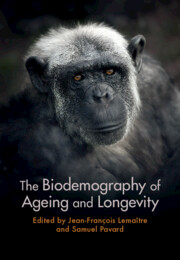Book contents
- The Biodemography of Ageing and Longevity
- The Biodemography of Ageing and Longevity
- Copyright page
- Dedication
- Contents
- Contributors
- Foreword
- Acknowledgements
- 1 The Eternal Youth of Ageing Research
- 2 Theories of Ageing across Ages
- 3 The Diversity of Longevity Metrics
- 4 The Meaning of ‘Exceptional Longevity’
- 5 The Inevitability of Senescence
- 6 The Untapped Potential of Zoo and Aquarium Data for the Comparative Biology of Ageing
- 7 Perspectives in Comparative Biology of Ageing
- 8 An Integrative Approach to Understanding Variation in the Form, Pattern and Pace of Ageing
- 9 Sex Differences in Lifespan, Ageing and Health in the Living World
- 10 Evolution of Human Reproduction, Ageing and Longevity
- 11 Lifespan and Mortality in Hunter-Gatherer and Other Subsistence Populations
- 12 Longevity in Modern Populations
- 13 Health Transition and Population Ageing
- 14 Limit of Human Longevity
- 15 Mortality Modelling at the Oldest Ages in Human Populations
- 16 Lessons from Exceptionally Long-Lived Individuals and Long-Living Families
- 17 Human Populations with Extreme Longevities
- 18 Socio-Economic Consequences of Increased Longevity in Contemporary Populations
- Index
- References
10 - Evolution of Human Reproduction, Ageing and Longevity
Published online by Cambridge University Press: 14 November 2024
- The Biodemography of Ageing and Longevity
- The Biodemography of Ageing and Longevity
- Copyright page
- Dedication
- Contents
- Contributors
- Foreword
- Acknowledgements
- 1 The Eternal Youth of Ageing Research
- 2 Theories of Ageing across Ages
- 3 The Diversity of Longevity Metrics
- 4 The Meaning of ‘Exceptional Longevity’
- 5 The Inevitability of Senescence
- 6 The Untapped Potential of Zoo and Aquarium Data for the Comparative Biology of Ageing
- 7 Perspectives in Comparative Biology of Ageing
- 8 An Integrative Approach to Understanding Variation in the Form, Pattern and Pace of Ageing
- 9 Sex Differences in Lifespan, Ageing and Health in the Living World
- 10 Evolution of Human Reproduction, Ageing and Longevity
- 11 Lifespan and Mortality in Hunter-Gatherer and Other Subsistence Populations
- 12 Longevity in Modern Populations
- 13 Health Transition and Population Ageing
- 14 Limit of Human Longevity
- 15 Mortality Modelling at the Oldest Ages in Human Populations
- 16 Lessons from Exceptionally Long-Lived Individuals and Long-Living Families
- 17 Human Populations with Extreme Longevities
- 18 Socio-Economic Consequences of Increased Longevity in Contemporary Populations
- Index
- References
Summary
Lifespan is just one component of a species life history. To understand human longevity from an evolutionary perspective, it is important to consider the human species’ phylogenetic history and the evolution of the entire human life cycle. This chapter extends previous fundamental reviews in the light of recent findings, and with particular emphasis on the evolution of longevity of the human species. It first compares the primate life cycle to that of other terrestrial mammals, and highlights the evolution of the slow pace of life observed in primates. It then compares the life cycles of humans and other primates, emphasizing the peculiarities of the human life cycle. The chapter outlines the main theories explaining the evolution of these peculiar life history traits that occurred since the human-chimpanzee divergence, linking these to the evolution of human reproduction, ontogenesis, diet and cognition. It then emphasizes the pivotal roles of sociality and intergenerational transfers for understanding the joint evolution of the human life cycle, biology and cognitive, linguistic and social capabilities. Together, this finally allows a contemplation of the most probable scenario joint evolution of human reproduction, ageing and longevity.
Keywords
- Type
- Chapter
- Information
- The Biodemography of Ageing and Longevity , pp. 190 - 216Publisher: Cambridge University PressPrint publication year: 2024

